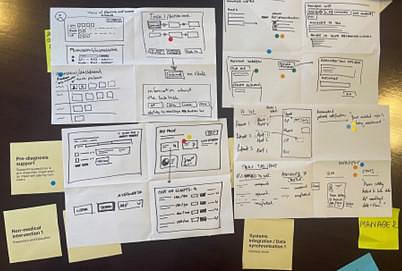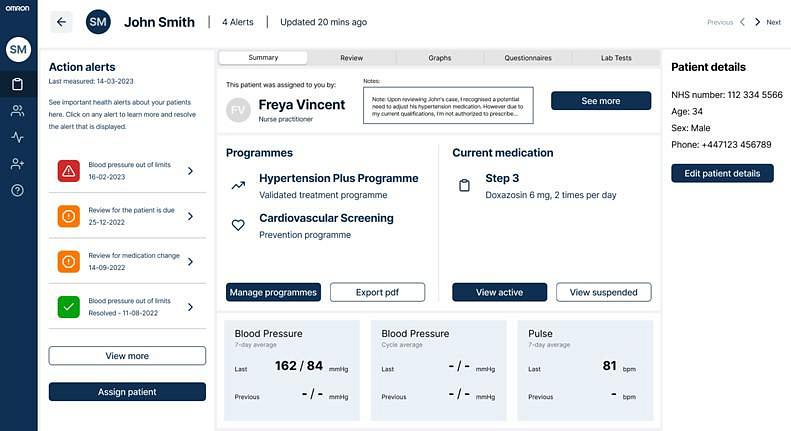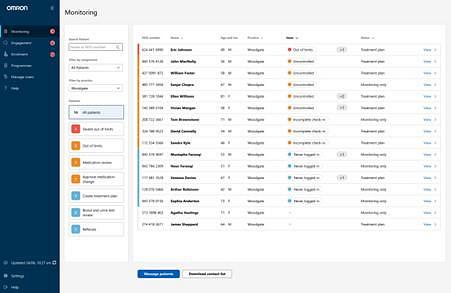Collaboratively Addressing Diverse Needs in Chronic Disease Management

Harnessing mixed methods research and co-design principles, OMRON is distinguishing itself in a complex market by cultivating a profound understanding of both patients and healthcare practitioners. This strategic approach underscores OMRON's commitment to innovation and user-centric solutions.
The Challenge
As a leader in global automation, OMRON boasts a wide-reaching presence across diverse sectors including industrial automation, social systems, and healthcare, with a product footprint spanning over 130 countries.
User Vision were engaged by OMRON’s healthcare division, who were preparing for the launch of an ambitious multi-disease platform. This innovative service empowers GPs to effectively manage a spectrum of chronic conditions including hypertension, COPD, and heart failure. Through a mobile app, patients monitor their vitals and symptoms, seamlessly interfacing with the GP dashboard to promptly flag any measurements of concern, which warrant further investigation.
Recognising the paramount in developing a safety-critical system for people managing complex situations, OMRON prioritised an in-depth understanding of both patient and healthcare practitioner contexts and requirements. To this end, OMRON entrusted User Vision with undertaking a comprehensive research and design initiative. The overarching goal was to ensure that the solution met its intended purpose, mitigating the risk of user errors, and championing inclusivity and accessibility across the board.
User Vision Approach
User Vision embarked on an in-depth mixed-methods approach, delving into the experiences of healthcare practitioners and patients grappling with long-term conditions. Leveraging this insight, we supported the OMRON team (both in Japan and the Netherlands) in crafting product and service designs that are not only highly effective but also resonate with the needs of the diverse user base.
Research and Service Design

The User Vision team embarked on an extensive series of research studies involving UK-based GPs and patients. Through qualitative contextual interviews with a diverse array of healthcare practitioners spanning various medical practices, we gained profound insights into their usage contexts, core needs, and platform expectations. This invaluable understanding informed the design of both patient and GP interfaces, with prototypes tailored to address user requirements while accounting for observed behaviours and usage contexts.
Subsequently, we conducted multiple rounds of usability testing, closely observing target users as they navigated typical tasks within the interfaces. Despite the inherent challenge of recruiting specialised and time-constrained healthcare professionals, we successfully identified suitable participants, and this iterative process allowed us to pinpoint potential user errors and refine prototype designs to deliver an experience that was efficient and easy to use.

Upon the completion of design iterations, we conducted a comprehensive evaluation of the platform in alignment with the international standard IEC62366-1, which governs the application of usability engineering to medical devices. This evaluation, aimed at assessing any device intended for use by medical practitioners and/or patients, sought to eliminate risks to patient safety arising from product usability. The assessment outcomes provided OMRON with the assurance needed to advance confidently with platform development, grounded in evidence-based design principles.
Accessibility
In addition to producing a service that was intuitive and engaging, it was equally important to the OMRON that the service could be used by the widest possible audience. Therefore, prioritising compliance with all pertinent accessibility standards was paramount.
User Vision conducted accessibility audits encompassing the product website, GP dashboard, and patient app, scrutinising both desktop and mobile platforms against the Web Content Accessibility Guidelines (WCAG) v2.1 to Level AA. Following the application of necessary fixes, we conducted thorough spot checks to confirm the resolution of identified issues, eventually ensuring 100% compliance with WCAG 2.1 AA standards.
Throughout this process the User Vision team provided ad-hoc consultancy to OMRON, aiding development and design teams in tackling issues on a granular level, encompassing both code and design adjustments.
Upon the conclusion of the audits, User Vision crafted three distinct accessibility statements for the platforms, tailored to meet the diverse needs of various disabled user groups. These statements provided comprehensive insights into the specific enhancements and modifications integrated into the system, fostering transparency and clarity.
Outcome

User Vision have forged a robust partnership with OMRON over the course of multiple projects. This collaboration enables OMRON to streamline the experiences of healthcare practitioners and patients within a highly complex problem space. Our research is continually enriching OMRON's efforts in developing and optimising a pivotal healthcare platform.
Partnering with User Vision has proved to be instrumental for the successful launch of Viso as well as in further improving it according to our customers’ needs.
Adoption of this kind of remote patient monitoring platforms in a sustainable manner can only happen if they support and streamline existing ways of working of healthcare professionals and if they manage to engage patients consistently. To this end User Vision helped us in capturing potential improvements in the existing platform but also in identifying user needs that go beyond its initial implementation.
Our close collaboration resulted in a comprehensive prototype that was tested and iterated upon rapidly. This allowed us to further develop the platform, resulting in positive feedback from our customers. They noted that our solutions really took their concerns at heart and were surprised with the speed with which we were able to do so.